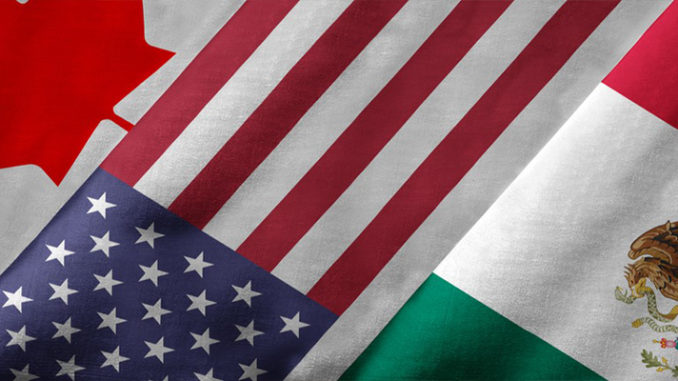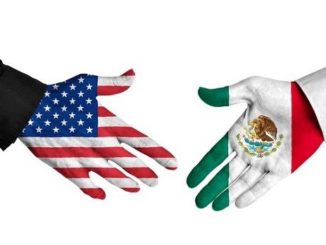
In response to: Twenty-Five Years of NAFTA
One of the curious features of the political debates about trade before 1994, when the North American Free Trade Agreement came into force, was that the proposal for a trilateral trade framework was more strongly opposed in the United States and Canada than it was in Mexico. The last-mentioned was barely emerging from a “lost decade” characterized by vicious cycles of runaway inflation, debt default, and currency devaluation. Mexico’s development agenda, moreover, had up to that point leaned far more on import-substitution and industrial protectionism than on open trade and global integration.
Yet, free trade in North America was (generally) embraced by Mexicans as a positive and forward-looking change. Their main concern at the time was that substantial economic “asymmetries” between Mexico and its northern neighbor would occasion dislocation among local companies and business concerns, which were not accustomed to competing on a global basis—say, in areas like textiles, plastics, or agriculture. In her Liberty Forum essay, Veronique de Rugy mentions Ross Perot’s fears of a “great sucking sound” of jobs fleeing south; the comment was deemed rather odd, considering that Mexico’s economy was barely the equivalent in size of the economy of the state of Florida.
As de Rugy acknowledges in her essay, the benefits of NAFTA were significantly oversold to the people of the United States. This was also true in Mexico, as the administration of President Carlos Salinas de Gortari argued that the accord (legally, it has the status of a treaty in Mexico) would immediately usher the country to first-world prosperity. Nor did it help matters that NAFTA took effect in 1994, a year that is better remembered south of the Rio Grande for dramatic setbacks, such as the Zapatista armed rebellion in the southern state of Chiapas, the assassination of Luis Donaldo Colosio as he campaigned in Tijuana for Mexico’s presidency, and the devastating “tequila” peso crisis.
Yet, a quarter of a century later, there is very little debate in Mexico about whether open trade in North America should continue. Mexicans, wherever they fall on the political spectrum, mostly favor further integration, and say they want a freer flow of capital and labor. The new administration of the would-be populist Andrés Manuel López Obrador (AMLO) has even committed to pushing for legislative approval of the United States-Mexico-Canada Agreement, NAFTA’s successor.
The Agreement Has Brought Stability
In fact the fundamentally transformational effect that NAFTA has had across Mexican society—even beyond the exponential growth in trilateral trade that it brought about—is all too often understated. The political logic of NAFTA, for Mexico, was to safeguard trade liberalization through a “lock-in” effect. In theory, unilateral liberalization is the best trade option. No treaties or accords or negotiations are needed for this. However, in a nation with Mexico’s history of authoritarian, interventionist, and statist practices, the key to trade liberalization lay in finding a mechanism that would resist the reflex to pull back and thus lessen the probability of unilateral de-liberalization in the future. As over 80 percent of Mexico’s trade and investment is with the United States, NAFTA provided a framework of credibility for long-term investment, one that has been (almost) immune to the caprices of changing political tides at home.
Luis Rubio has explained the benefits to Mexico of this extra-commercial, shall we call it institutional, feature of NAFTA. The ultimate value of the treaty was the recognition of “the incapacity of existing institutions to give investors the certainty they require for long-term growth.” Not surprisingly, foreign investment flows grew significantly once the agreement was in place, reaching an average of $24 billion per annum in recent years. Also, growth rates in the Mexican states with NAFTA-enhanced industry have tended to be robust, akin to those seen in successful market-oriented emerging markets.[1]
Thus de Rugy’s understatement in saying that there is “also some evidence that it helped make the Mexican economy a bit more stable.” The stabilizing effect was deep. No, NAFTA did not issue in the golden guarantee of competitiveness that its proponents (including myself) originally visualized; but it has straightjacketed bad public policies (such as a potential re-expropriation of the banking system immediately after the 1994 peso devaluation). Also, as de Rugy herself notes, it enabled a positive reshaping of North American economic ties, with integrated supply chains that today extend all the way from Anchorage to Tuxtla Gutierrez.
Suffice it to say that the economic realities that ensued in the last quarter century have been far from boring, at least for Mexico. The main challenge for entrepreneurs and business interests (besides addressing the chronic problems of crime and corruption) has shifted from worries of currency exposure and loss of purchasing power, to real and permanent cost-reduction based on business strategy, labor flexibility, and the reduction of transaction costs. To this extent, the economic realities today reflect a paradigm shift to a culture of competition. Mexico exports the equivalent of more than $1 billion in manufacturing goods per day, and it imports a similar amount. Open trade (on all borders) has enabled Mexico to radically diversify its external sector. Oil and oil derivatives represented almost 80 percent of total exports in the past; now, they are less than 8 percent.[2] Two-way trade reached over $550 billion in 2017, which represents a more than five-fold increase since 1994.
A Growing Mexican Ag Sector and a Growing Middle Class
Manufactured products and parts now make up the vast majority of total sales abroad. The U.S.-Mexico border zone is now the largest manufacturing corridor in the world, and one of the most dynamic economic regions in the past 50 years, with virtually full and highly flexible mobility of goods, services, capital, and even labor. Border points such as Nogales, Arizona and Nogales, Sonora now form extremely active trading centers, where consumers on both sides trade goods like gasoline, natural gas, watermelons, auto parts, computer chips, cereals, blueberries, flowers, and much more. The Texas-Mexico region, now referred to as “Texico,” has become the sixth largest trade region in the world, with over $178 billion in total trade.[3]
Proximity, lower transportation costs, and affordable logistics have moreover enabled Mexico to become a preferred destination for industrial production. Typically a 50-foot container from heartland (south) to heartland (north) takes only four days to transport, at two-thirds of the total price of maritime- and land-shipping costs if the same goods were transported from the Far East.
Mexico’s agricultural sector has also benefited from regional trade. A lot of editorial ink has been spilt on the devastation wrought by NAFTA on our rural economy. The factual evidence tells a very different story. Rural productivity has increased significantly, as producers of perishables like mangos, avocados, or tomatoes reap the benefits of economies of scale, technologies, the ability to partner with northern parties, and a far more extensive market. In fact agricultural sales north of the border have skyrocketed, from $3 billion in 1993 to over $25 billion a quarter of a century later.
Most talk of trade concentrates on exports. In Mexico’s case, a boom has also been observed in capital and consumer imports, which, coupled with credible monetary policy targeting a stable purchasing power during the same timeframe, has fostered the emergence of a healthy Mexican middle class. Despite fundamental problems with poverty and low per capita growth, over 55 percent of Mexico’s population exhibits behavior patterns typical of middle-class consumers: the use of credit to purchase low-cost goods and services, greater access to technology services, and predictable spending patterns.
Mexican consumers spend a great deal on imports—that is, almost $350 billion per annum, with 87 percent of the imported products originating in the United States. And, although capital imports constitute the majority of annual receipts, Mexican households have enjoyed a sharp rise in consumer goods, such as electronics and refrigerators, coming from both of its northern trading partners.
De Rugy writes that perhaps the USMCA should have included incentives for Mexico to “privatize” its state-owned companies. This point deserves some precision. Despite the (very real) threat of an AMLO administration backlash against some market-oriented reforms, Mexico has already accomplished an ambitious energy reform, with constitutional changes to allow private investment in the energy sector, in areas such as deep-sea drilling, exploration, and the marketing of oil and oil derivatives, as well as the processing of natural gas deposits. The reform regime allows for investment in the entire productive chain, including refining, transportation, storage, distribution, and sales. It also applies a similar liberalization to electricity, thereby de facto ending the state monopoly on the production and distribution of electricity.
All these oil-related activities were previously reserved to Petróleos Mexicanos (Pemex). The change mandates transformation of Pemex into a “productive company” with independent board members from the private sector and corporate governance rules. The company must now compete in the energy sector alongside other players.
The key aspect of energy reform is that the sectors involved immediately gained NAFTA status, with preferred access and institutional guarantees for the United States and Canada. So construed, AMLO’s hostility toward private participation in oil production and distribution, as well as in electricity, represents a crucial test of the institutional straightjacket effect of three-way trade integration. We shall see if the NAFTA effect will continue to hold, and to bolster the long-term institutional stability of a Mexico used to greater commercial competition. Over two thirds of its economy depends on the tradable sector. It would be hard to imagine a broad-based withdrawal from an arrangement that has been so important for Mexico, and whose approval spans the political spectrum. The problem in this regard is not here, but north of the border.
“Distant Neighbors” Again?
These facts and figures suggest why President Trump’s hostility toward Mexico and his threat to cancel NAFTA were met here with disappointment, if not outright disbelief. What went wrong? Adam Smith was arguably right when he observed the paradox that “commerce, which ought to be a bond of . . . union and friendship, [becomes] a fertile source of discord and animosity.” As Luis Rubio and others have noted, Trump’s rhetorical onslaught against NAFTA undermined the idea that abandoning the accord was an “untouchable” option, and may well have weakened the policy straightjacket that has been preventing a return to protectionism south of the border. The American stance has reintroduced an element of long-term uncertainty among trading partners who believed they had, at long last, ceased to be “distant neighbors.”
There is little doubt that NAFTA required an update—especially in removing lingering trade barriers (for instance, in oil and electricity in Mexico). However, the USMCA framework, as de Rugy notes, constitutes a step backward (even while some elements are welcome). Most of the “toxic” proposals were suppressed, in particular in dispute-resolution, the seasonality of agricultural goods, and the infamous “sunset clause.” Still, the damage is done; and a failure to approve the new agreement in the United States risks reigniting the visceral anti-NAFTA narrative as “stupid trade” or “the worst deal in history.”
One of the most significant harms inflicted by the political change in the United States derives from the Trump administration’s obsession with reading the balance of payments as an income statement, where a trade deficit with Mexico (of $61 billion in 2017) is seen as “unfair” or, worse, as a permanent loss. The use and abuse of trade deficits as a measure of fairness sets a misleading precedent, not only in reviving the mercantilist confusion of money (cash) with wealth, but also in empowering the false assumption that trade deficits (a statistic whose measurement depends on a host of other factors, including the level of savings, high or low growth rates, the persistence of fiscal deficits, new investment inflows, and more) are, by definition, bad.
Krugman and Bastiat
Paul Krugman shares a terrific thought experiment (reminiscent of Frédéric Bastiat’s examples) to show the meaninglessness of trade deficits as a measure of good or bad, or fair or unfair, trade. Suppose we omit all imports and exports coming in and out of New York City from the calculation of the U.S. balance-of-payments accounting—on the grounds, say, that the Big Apple is actually a financial global capital (or whatever excuse). If so, every good that New York purchased from abroad would no longer count as an import; also, all goods that the United States sold to New York would count as exports.
An instant consequence of this change would be that, in one fell swoop, a lot of red ink would be erased from the balance of payments. New York basically imports all of its goods, and exports nothing but services. Krugman notes that nothing would change in the real economy or individual decisions to buy or sell, but a lot of pop internationalists would surely be able to sleep better at night. The key principle of international trade, Krugman observes, is “mutually beneficial exchange.” And the purpose of trade is to “transform” exports into imports.[4]
In my opinion, the existence of a U.S. trade deficit or a surplus with Mexico (or with Canada) should be as irrelevant to future trade relations as the existence of a deficit between, say, Alabama and Oregon; or my own household with the local supermarket in my neighborhood.
Doug Irwin argues powerfully that the key to enhancing trade among the North American partners is “reciprocity of market access.”[5] The impetus of greater trade in North American and the existence of new and highly integrated supply chains suggests that a new round of negotiations should have had us looking to the future, to consider elements such as greater labor flexibility, much larger private investment in border infrastructure (similar, say, to the remarkable San Diego-Tijuana cross-border bridge), a regional policy of open skies, or greater capital market integration. Instead, despite the massive empirical evidence suggesting a quarter century of demonstrable success in trilateral trade, citizens are arguing about tariffs, trade deficits, restrictions, and even a border wall.
To not coin a phrase: sad!
Clearly, an important lesson here is that the proponents of open trade in the region must better explain why free—and failing that, freer—trade is a win-win equation about mutually beneficial exchange between all of the citizens of North America.
[1] Luis Rubio, “A Mexican Utopia: The Rule of Law Is Possible,” monograph published by the Woodrow Wilson International Center for Scholars, Washington, D.C., January 27, 2015, p. 59.
[2] In fact, Mexico has, alas, a substantial deficit in the energy balance of payments with the United States! And very fortunately so, as it lacks capacity to refine and commercialize finished oil products, such as gasoline.
[3] See W. Michael Cox and Richard Alm, “Texico: The Texas-Mexico Economy and Its Uncertain Future,” William J. O’Neil Center for Global Markets and Freedom, 2017-2018 Annual Report, SMU Cox School of Business.
[4] Paul Krugman, Pop Internationalism (The MIT Press, 1996), pp. 120-121. Veronique de Rugy makes very similar and very clear comments in “How Trump Misunderstands Trade,” New York Times, April 10, 2018.
[5] Doug Irwin, Clashing Over Commerce: A History of U.S. Policy (University of Chicago Press, 2017); see in particular the chapter entitled, “From Globalization to Polarization,” pp. 625-689.
Dr. Roberto Salinas-León is President of the Mexico Business Forum in Mexico City, and director of Atlas Network Center for Latin America.


